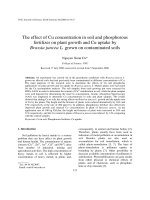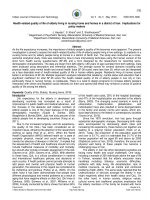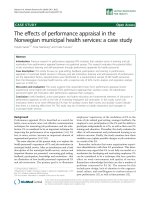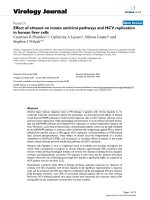Effect of liver transplantation in combined hepatocellular and cholangiocellular carcinoma: A case series
Bạn đang xem bản rút gọn của tài liệu. Xem và tải ngay bản đầy đủ của tài liệu tại đây (427.38 KB, 6 trang )
Wu et al. BMC Cancer (2015) 15:232
DOI 10.1186/s12885-015-1252-7
RESEARCH ARTICLE
Open Access
Effect of liver transplantation in combined
hepatocellular and cholangiocellular carcinoma: a
case series
Di Wu, Zhong-Yang Shen*, Ya-Min Zhang*, Jian Wang, Hong Zheng, Yong-Lin Deng and Cheng Pan
Abstract
Background: Liver transplantation is a treatment option for combined hepatocellular and cholangiocellular carcinoma
(cHCC-CC) but its prognostic significance remains unclear. The present study aimed to evaluate the therapeutic effects
of liver transplantation on cHCC-CC and analyze the clinicopathological factors affecting prognosis.
Methods: Retrospective analysis of the clinicopathological data of a case series of 21 patients with cHCC-CC who
underwent orthotopic liver transplantation from April 2000 to April 2011 was performed. Cumulative survival rate and
tumor-free survival rate were calculated using the Kaplan-Meier method followed by the log-rank test.
Results: The operative survival rate of the 21 patients was 100%; the 30 day mortality was 4.8% (1/21) and 90-day
mortality was 9.5% (2/21); 1-, 2-, 3-, and 5-year overall cumulative survival rates were 64%, 47%, 39%, and 39%,
respectively; and the corresponding cumulative tumor-free survival rates were 64%, 37%, 30%, and 30%, respectively.
Cumulative tumor diameter, lymph node metastasis, macroscopic portal vein tumor thrombus, and mixed states
according to Allen typing were identified as the primary influencing factors of poor prognosis (all P < 0.05).
Conclusion: Liver transplantation may be an effective therapeutic method for the treatment of cHCC-CC. Strict screening
of potential liver transplantation candidates with cHCC-CC can help reduce the risks of tumor recurrence and metastasis.
Keywords: Combined hepatocellular and cholangiocellular carcinoma, Liver neoplasm, Cholangiocarcinoma,
Liver transplantation, Prognosis, Recurrence, Neoplasm recurrence, Local
Background
Combined hepatocellular and cholangiocellular carcinoma (cHCC-CC) is an uncommon but discrete variant
of primary liver cancer, with different biological behavior
from hepatocellular carcinoma (HCC) and cholangiocellular carcinoma (CC). It accounts for 0.4–14% of all
primary malignant liver tumors [1]. Histologically the
tumor demonstrates features of both hepatocellular and
cholangiocellular epithelial differentiation [2]. cHCC-CC
is more common in males than in females [3]. The median survival of patients with non-surgical treatment is
approximately four months; and the respective 1-, 3-,
and 5-year survival rates have been shown to be 26.5%,
12.5%, and 9.2%, respectively [1]. The accompanying disease characteristics include hepatitis B virus/hepatitis C
* Correspondence: ;
Department of Hepatobiliary Surgery, Orient Organ Transplant Center, The
First Center Hospital of Tianjin, Tianjin 300192, China
virus infection, liver cirrhosis, vascular thrombosis, and
hilar lymph node metastasis. Some of the features of
cHCC-CC such as association with hepatitis virus and
portal vein thrombosis are similar to HCC [4], whereas
other features such as poor blood supply to the tumor
and early onset of hilar and retroperitoneal lymph node
metastasis are similar to CC [5]. The clinical features of
cHCC-CC may be related to the dominant component
in the tumor body. When bile duct-derived cancer cells
are absolutely dominant in the tumor body, cHCC-CC
clinically manifests to be more similar to CC.
Therapeutic methods for cHCC-CC include conservative treatment, liver resection (hepatectomy), and liver
transplantation [3]. Other methods including local ablation (e.g., ethanol injection, microwave coagulation, and
radiofrequency ablation [RFA]) and transcatheter arterial
chemoembolization (TACE) have proved effective only
in a small number of cases [6]. Local treatment methods
© 2015 Wu et al.; licensee BioMed Central. This is an Open Access article distributed under the terms of the Creative
Commons Attribution License ( which permits unrestricted use, distribution, and
reproduction in any medium, provided the original work is properly credited. The Creative Commons Public Domain
Dedication waiver ( applies to the data made available in this article,
unless otherwise stated.
Wu et al. BMC Cancer (2015) 15:232
such as TACE and percutaneous ethanol injection may
have poor efficacy because of abundant interfibrillar substances and the poor blood supply found in cHCC-CC [7].
Liver resection can prolong the survival of a patient with
cHCC-CC who has an early tumor stage and liver function
that is tolerant to resection, and has achieved postoperative median survival times of 20 to 47 months [1].
Liver transplantation provides an option for the treatment of cHCC-CC in patients intolerant to liver resection [8]. The advantages of liver transplantation are
better dissection of lymph nodes, elimination of background diseases of liver cancer, and no postoperative risk
of liver dysfunction due to liver resection. Patients with
cHCC-CC receiving liver transplantation have shown
better survival than the same-stage patients with cHCCCC undergoing hepatectomy [3,8]. Similarly, liver transplant recipients with HCC have better survival rates than
patients with cHCC-CC [9].
The clinical outcome of liver transplantation in patients
with hepatocellular carcinoma (HCC) is well defined. But,
there are fewer clinical reports available on liver transplantation in the treatment of cHCC-CC, and factors relevant to its prognosis remain unclear. The present study
aimed to explore the clinical efficacy of liver transplantation in patients with cHCC-CC and evaluate the effects
of different clinicopathological factors on prognosis of
cHCC-CC. This information should add important data to
that already available on the best treatment option for patients with cHCC-CC and whether liver transplant should
be selected.
Methods
Clinical data
From April 2000 to April 2011, a cases series of 21 patients with cHCC-CC who underwent orthotopic liver
transplantation (OLT) were selected from the First
Center Hospital of Tianjin (Tianjin, China). This study
was approved by the ethics committee of the First
Center Hospital of Tianjin (E2014008L) and complied
with the Declaration of Helsinki, and all participants
provided written informed consent.
The cases included male patients whose diagnoses were
pathologically confirmed as cHCC-CC with an age of onset of 35 to 65 years (mean age, 53 years). Twenty patients
had hepatitis (fifteen with hepatitis B, four with hepatitis
C, and one with hepatitis B and C) and one patient did
not have hepatitis. According to the Child-Pugh classification of severity of liver disease, patients with cHCC-CC
were classified as follows: sixteen patients with Grade A
liver disease, three patients with Grade B liver disease, and
two patients with Grade C liver disease. Prior to liver
transplantation, 13 patients had not received preoperative
adjuvant therapy. While eight patients had received
preoperative adjuvant therapy including TACE and/or
Page 2 of 6
radiofrequency ablation (RFA, n = 7) and chemotherapy
pump placement (n = 1). The patients’ preoperative serum
α-fetoprotein (AFP) level (n = 13) was >20 ng/mL and
preoperative carbohydrate antigen 19–9 (CA 19–9) level
(n = 12) was ≥ 37U/mL.
Intraoperatively resected liver tissues were used for routine histopathological examinations. In the 21 cases 18 patients had cirrhosis while the remaining three patients had
no cirrhosis. Five patients had single tumors, eight patients
had 2 to 3 tumors, and eight patients had ≥ 4 tumors.
Twelve patients had tumor lesions in the right lobe, while
the remaining nine patients had tumor lesions in both the
right and left lobes of the liver. Cumulative tumor diameter (the maximal diameter of single tumors or the sum of
tumor diameters for multi-tumors) was ≤5 cm in four patients, 5 to 10 cm in seven patients, and >10 cm in ten patients. Patients also had accompanying diseases such as
hilar lymph node metastasis (n = 5), macroscopic portal
vein tumor thrombus (n = 8), and microvascular thrombosis (n = 14). The component in HCC was moderately or
well differentiated in sixteen patients and poorly differentiated in five patients. The component in CC was moderately or well differentiated in twelve patients and poorly
differentiated in nine patients. According to the typing
method of Allen et al., [10] there were twelve patients in
the separation state, three patients in the collision state,
and six patients in the mixed state.
All 21 patients underwent conventional non-bypass
OLT from a cadaver donor of the same blood type.
Postoperatively, the patients received a standard triple
immunosuppressive therapy with hormone + tacrolimus
(FK506) + mycophenolate mofetil (CellCept®) for three
months. Thereafter, tacrolimus (FK506) was administered individually to maintain blood trough concentration at 3 to 6 ng/mL.
Follow-up
All patients were either hospitalized or visited as outpatients for follow-up. There were no patients lost to follow
up. The patients were re-examined postoperatively by abdominal ultrasound, chest x-ray, and blood tests (serum
AFP and CA 19–9 measurements) monthly, and at six
months and quarterly thereafter. The patients underwent
a chest and abdominal computed tomography scan, and
bone scan for diagnosis of tumor recurrence. The time
and cause of death were followed up.
Statistical analysis
Data were statistically analyzed using SPSS, version 15.0
(SPSS Inc., Chicago, IL, USA). Cumulative survival rate
and tumor-free survival rate were calculated using the
Kaplan-Meier method, followed by the log-rank test for
univariate analysis. A P-value of less than 0.05 was considered statistically significant.
Wu et al. BMC Cancer (2015) 15:232
Page 3 of 6
Results
Follow-up results
As of April 2013, 14 recipients of liver transplants survived over a year. In the 21 case series, the operative
survival rate of the patients was 100%, the 30 day
mortality was 4.8% (1/21) and 90-day mortality was
9.5% (2/21). One patient died due to an aneurysm rupture and bleeding during the first postoperative month.
Another two patients died due to lung infection two
and four months postoperatively. 8 of the 21 patients
recurred or died of procedure related events within
6 months of transplant. Among these 8 patients, 3 had
lymph nodes metastases.
The cumulative 1-, 2-, 3-, and 5-year overall survival
rates of the 21 patients with cHCC-CC were 64%, 47%,
39%, and 39%, respectively (Figure 1).
The cumulative 1-, 2-, 3, and 5-year tumor-free survival rates of the patients with cHCC-CC were 64%,
37%, 30%, and 30%, respectively (Figure 2).
The median survival time of the 21 patients with
cHCC-CC was 23 months.
Figure 2 Cumulative 1-, 2-, 3-, and 5-year tumor-free survival of
patients with hepatocellular and cholangiocellular carcinoma
after liver transplantation. Tumor-free survival: 1-year tumor-free
survival: 64%, 2-year tumor-free survival: 37%, 3-year tumor-free survival:
30%, 5-year tumor-free survival: 30%.
Univariate analysis
The univariate analysis of relevant clinicopathological
factors showed that the influencing factors of poor prognosis included cumulative tumor diameter, lymph node
metastasis, macroscopic portal vein tumor thrombus,
and mixed states according to Allen type (all P < 0.05)
(Table 1).
Figure 1 Cumulative 1-, 2-, 3-, and 5-year overall survival of
patients with combined hepatocellular and cholangiocellular
carcinoma after liver transplantation. Overall survival: 1-year
overall survival 64%, 2-year overall survival 47%, 3-year overall
survival 39%, 5-year overall survival 39%.
Baseline characteristics of patients whose tumor recurred
within 1 or 2 years
Of the 21 patients, 7 showed recurrence of tumors during the first year (33.3%) and 11 within 2 years (52.4%)
(Table 2). The patients that had tumor recurrence within
1 year showed mean tumor sizes of 11.86 ± 2.90 cm in
diameter and within 2 years 11.00 ± 4.13 cm in diameter.
Patients whose tumor recurred within 1 or 2 years had
similar presence of lymph node metastases, 2/7 (28.6%)
and 3/11 (27.3%), respectively. Of the patients with
tumor recurrence within 2 years, 9 (81.8%) had cirrhosis
(Table 2).
Discussion
Although relatively rare, cHCC-CC accounts for 0.4–
14% of primary liver cancers [1]. There is some evidence
that liver transplantation may be the best available treatment for improving survival rates [3,9]. The aim of this
investigation was to retrospectively assess the outcomes
of patients with cHCC-CC undergoing liver transplant
and to investigate the factors that might be involved in
the prognosis of the patients. We found that the fiveyear overall survival rate was 39%. Univariate analysis
suggests that prognosis is related to the clinicopathological factors of cumulative tumor diameter, lymph node
metastasis, macroscopic portal vein tumor thrombus
and mixed states according to Allen type.
In the present study, the cHCC-CC disease manifestations of the 21 male patients were as follows: combined
Wu et al. BMC Cancer (2015) 15:232
Page 4 of 6
Table 1 Effects of different clinicopathological factors on
the survival of patients with combined hepatocellular
and cholangiocellular carcinoma after liver
transplantation
Prognostic factors
Cases
(%)
Mean survival P-value
time (month)
Age
<50-year
≥50-year
7 (33%)
14 (67%)
50.8 ± 18.1
0.899
45.0 ± 11.8
13 (62%)
46.7 ± 12.3
TACE, RFA, or chemotherapy
8 (38%)
49.0 ± 14.1
0.769
≥20 ng/mL
8 (38%)
13 (62%)
44.0 ± 17.2
0.898
37.1 ± 9.5
9 (43%)
53.6 ± 15.8
≥37U/mL
12 (57%)
48.8 ± 8.9
Grade A
16 (76%)
47.3 ± 13.1
Grade B
3 (14%)
39.1 ± 9.1
Grade C
2 (10%)
53.6 ± 12.0
No
3 (14%)
9.0 ± 1.0
Yes
18 (86%)
52.8 ± 11.1
Right lobe
12 (57%)
53.5 ± 12.9
Double lobes
9 (43%)
41.3 ± 10.2
4 (19%)
83.5 ± 16.9
0.347
Cirrhosis*
0.031
Tumor distribution
0.265
Cumulative tumor diameter*
5–10 cm
7 (33%)
32.8 ± 10.1
>10 cm
10 (48%)
17.7 ± 4.0
5 (24%)
37.3 ± 19.2
0.047
Tumor quantity
Singular
2–3
8 (38%)
50.3 ± 14.8
≥4
8 (38%)
34.3 ± 13.0
Yes
5 (24%)
14.0 ± 6.1
No
16 (76%)
54.7 ± 11.7
Intermediate to well
differentiated
16 (76%)
54.3 ± 15.2
Poorly differentiated
5 (24%)
45.6 ± 12.1
Intermediate to well
differentiated
12 (57%)
56.7 ± 9.3
Poorly differentiated
9 (43%)
41.0 ± 13.8
21.0 ± 5.1
No
13 (62%)
57.9 ± 13.1
Yes
14 (67%)
42.5 ± 12.5
No
7 (33%)
58.8 ± 14.9
Separation/collision
15 (71%)
47.9 ± 9.9
Mixed
6 (29%)
21.3 ± 14.2
0.028
0.226
0.037
0.268
Child-Pugh Grading
≤5 cm
8 (38%)
Note: AFP = alpha-fetoprotein; CA19-9 = carbohydrate antigen 19–9;
CC = cholangiocellular carcinoma; HCC = hepatocellular carcinoma; RFA = radio
frequency ablation; TACE = transcatheter arterial chemoembolization.
* by the log-rank test, P < 0.05.
Preoperative CA19-9
<37U/mL
Yes
Allen typing*
Preoperative AFP
<20 ng/mL
Macroscopic thrombosis*
Microvascular thrombosis
Preoperative treatment
None
Table 1 Effects of different clinicopathological factors on
the survival of patients with combined hepatocellular
and cholangiocellular carcinoma after liver
transplantation (Continued)
0.084
Lymph node metastasis*
0.039
HCC differentiation
0.074
CC differentiation
0.083
hepatitis accounted for 95% (20/21), cirrhosis accounted
for 86% (18/21), vascular invasion accounted for 67%
(14/21), and lymph node metastasis accounted for 24%
(5/21). The present study results are consistent with the
data previously reported in the literature [6,11,12].
Kassahun and Hauss [1] comprehensively analyzed 424
cases of cHCC-CC in eighteen reports and indicated that
hepatitis virus infection plays an important role in the
pathogenesis of cHCC-CC. However, any differences in
the mechanisms underlying the pathogenesis of HCC
and cHCC-CC remain unclear.
In the present study, postoperative cumulative 1-, 2-,
3-, and 5-year survival rates of patients with cHCC-CC
treated by liver transplantation were 64%, 47%, 39%, and
39%, respectively; and the corresponding cumulative
tumor-free survival rates were 64%, 37%, 30%, and 30%.
The overall survival rate of patients who underwent surgical OLT was better than the rates for non-surgical
treatment as reported previously in the literature [6].
And the five-year overall survival was similar to previous
studies that have evaluated this measure although lower
than recent reports of 41% [3], 50% [13] and 60% [14] it
was better than another at 16% [15]. These values are
generally from small populations of patients because of
the rarity of this disease so the values may reflect different patient pathological factors.
Tumor size and number, vascular invasion, and lymph
node metastasis are important prognostic factors of liver
transplantation in HCC [16,17]. In the present study the
results of the univariate analysis showed that the cumulative tumor diameter, macrovascular invasion, and
lymph node metastasis significantly affected the postoperative survival of patients with cHCC-CC (all P < 0.05).
Preoperative diagnosis of lymph node metastasis is difficult due to a lack of specificity in imaging studies. This
Wu et al. BMC Cancer (2015) 15:232
Page 5 of 6
Table 2 Baseline characteristics of patients with combined hepatocellular and cholangiocellular carcinoma after liver
transplantation that had tumor recurrence within 1 or 2 years
Patients (n)
Age (years) Free- tumor Survival time Cumulative tumor Tumor
Lymph node Macroscopic Microvascular Cirrhosis
survival time (months)
diameter (cm)
quantity metastasis
thrombosis thrombosis
(months)
Recurred within
1 year
2
61
5
10
14
3
No
No
Yes
Yes
4
54
4
10
8
1
No
No
Yes
No
5
59
8
13
12
5
Yes
No
Yes
Yes
7
43
6
11
7
1
No
No
No
Yes
8
35
3
5
15
6
No
Yes
Yes
Yes
10
40
4
4
13
5
Yes
Yes
Yes
Yes
20
55
6
8
14
2
No
No
Yes
No
9
53
18
25
4
1
Yes
No
Yes
Yes
13
49
20
27
10
6
No
No
Yes
Yes
14
59
18
23
6
2
No
Yes
Yes
Yes
17
58
20
26
18
2
No
Yes
No
Yes
Recurred within
2 year
is because lymphadenopathy may also be caused by reactive hyperplasia of lymph nodes. Thus, it is necessary
to perform preoperative or intraoperative liver biopsy in
suspected cases. For instance, in the present study the
mixed states according to Allen typing posed significantly different influences on the prognosis from other
types. These data suggest that mixed-state tumors may
be more invasive than the other two types of tumor. The
present study results also found that 9 (81.8%) of the patients with recurrence within 2 years, had cirrhosis, this
is perhaps associated with tumor development. Due to a
lack of clinical cases, the above mechanism needs to be
explored in future studies.
Three patients who died early post operatively had
positive lymph nodes. One patient with lymph node metastasis died within 13 months and another patient with
lymph nodes metastasis died within 25 months. 8 of the
21 patients had disease recurrence or died of procedure
related events within 6 months of transplant. Among
these 8 patients, 3 patients had lymph node metastases.
This suggested that the effect of lymph node metastasis
was very important. Panjala et al. reported that the 5year survival rate after liver transplantation was only
16% in 12 patients with cHCC-CC without perineural or
adjacent lymph node metastasis [15]. Because patients
with lymph node metastasis had a poorer survival rate,
we recommend freezing a section of suspicious lymph
nodes at the time of surgical exploration or diagnostic
laparoscopy prior to performing a transplant and the information this provides should alter the decision of
whether to transplant or not. Careful selection of
patients without lymph node metastasis may help to improve survival rates and reduce tumor recurrence rates
in patients with cHCC-CC after liver transplantation.
A significant limitation of this study is the relatively
few cases of cHCC-CC that were encountered and suitable for liver transplant, necessarily resulting in a small
sample size. This may introduce some bias in the analysis of factors related to patient prognosis, giving some
unexpected results such as longer term survival of the
patients with cirrhosis of the liver.
Conclusion
In conclusion, liver transplantation may be an effective
clinical therapy with prolonged survival for a subgroup of
patients with cHCC-CC. However, recurrence within the
first two years is common, suggesting the need to develop
selection criteria for OLT in this pathologic entity. The
current study considers the effects of cumulative tumor
diameter, vascular invasion, lymph node metastasis, and
the type of cHCC-CC. Rigorous preoperative assessment
of these criteria could enhance patient selection for OLT
associated with cHCC-CC, thereby leading to reduced
postoperative tumor recurrence and improved survival.
Abbreviations
cHCC-CC: Combined hepatocellular and cholangiocellular carcinoma;
OLT: Orthotopic liver transplantation; AFP: Alpha-fetoprotein; CA199: Carbohydrate antigen 19–9; CC: Cholangiocellular carcinoma;
HCC: Hepatocellular carcinoma; RFA: Radio frequency ablation;
TACE: Transcatheter arterial chemoembolization.
Competing interests
The authors declare that they have no competing interests.
Wu et al. BMC Cancer (2015) 15:232
Page 6 of 6
Authors’ contributions
DW carried out the studies on liver transplantation for cHCC-CC, participated in
analysis of the clinical and pathological characteristics of cHCC-CC after liver
transplantation and drafted the manuscript. YMZ carried out the surgical
therapy of HCC, participated in the resection and liver transplantation.
JW conceived of the study, and participated in its design and coordination and
helped to draft the manuscript. HZ participated in the liver transplantation
operation. CP participated in the liver transplantation. ZYS carried out the study
of liver transplantation, participated in the criteria for liver transplantation.
All authors read and approved the final manuscript.
Authors’ information
Di Wu and Jian Wang are co-first authors.
Acknowledgements
This work was supported by National High Technology Research and
Development Program (863 Program) of China (Grant No.2012AA021001).
Received: 16 April 2014 Accepted: 25 March 2015
References
1. Kassahun WT, Hauss J. Management of combined hepatocellular and
cholangiocarcinoma. Int J Clin Pract. 2008;62:1271–8.
2. Jarnagin WR, Weber S, Tickoo SK, Koea JB, Obiekwe S, Fong Y, et al.
Combined hepatocellular and cholangiocarcinoma: demographic, clinical,
and prognostic factors. Cancer. 2002;94:2040–6.
3. Garancini M, Goffredo P, Pagni F, Romano F, Roman S, Sosa JA, et al.
Combined hepatocellular-cholangiocarcinoma: a population-level analysis of
an uncommon primary liver tumor. Liver Transpl. 2014;20:952–9.
4. Chantajitr S, Wilasrusmee C, Lertsitichai P, Phromsopha N. Combined
hepatocellular and cholangiocarcinoma: clinical features and prognostic
study in a Thai population. J Hepatobiliary Pancreat Surg. 2006;13:537–42.
5. Liver Cancer Study Group of Japan. Primary liver cancer in Japan.
Clinicopathologic features and results of surgical treatment. Ann Surg.
1990;211:277–87.
6. Ikai I, Arii S, Ichida T, Okita K, Omata M, Kojiro M, et al. Report of the 16th
follow-up survey of primary liver cancer. Hepatol Res. 2005;32:163–72.
7. Dick EA, Taylor-Robinson SD, Thomas HC, Gedroyc WMW. Ablative therapy
for liver tumours. Gut. 2002;50:733–9.
8. Chan AC, Lo CM, Ng IO, Fan ST. Liver transplantation for combined
hepatocellular cholangiocarcinoma. Asian J Surg. 2007;30:143–6.
9. Chen HL, Zheng H, Wang ZL, Zhu ZJ, Deng YL, Pan C, et al. Liver
transplantation in 14 patients with combined hepatocellular and
cholangiocellular carcinoma. Chin J Clin Oncol. 2009;36:486–9.
10. Allen RA, Lisa JR. Combined Liver Cell and Bile Duct Carcinoma. Am J
Pathol. 1949;25:647–55.
11. Koh KC, Lee H, Choi MS, Lee JH, Paik SW, Yoo BC, et al. Clinicopathologic
features and prognosis of combined hepatocellular cholangiocarcinoma.
Am J Surg. 2005;189:120–5.
12. Liu CL, Fan ST, Lo CM, Ng IO, Lam CM, Poon RT, et al. Hepatic resection for
combined hepatocellular and cholangiocarcinoma. Arch Surg. 2003;138:86–90.
13. Song S, Moon HH, Lee S, Kim TS, Shin M, Kim JM, et al. Comparison
between resection and transplantation in combined hepatocellular and
cholangiocarcinoma. Transplant Proc. 2013;45:3041–6.
14. Park YH, Hwang S, Ahn CS, Kim KH, Moon DB, Ha TY, et al. Long-term
outcome of liver transplantation for combined hepatocellular carcinoma
and cholangiocarcinoma. Transplant Proc. 2013;45:3038–40.
15. Panjala C, Senecal DL, Bridges MD, Kim GP, Nakhleh RE, Nguyen JH, et al.
The diagnostic conundrum and liver transplantation outcome for combined
hepatocellular-cholangiocarcinoma. Am J Transplant. 2010;10:1263–7.
16. Mazzaferro V, Regalia E, Doci R, Andreola S, Pulvirenti A, Bozzetti F, et al.
Liver transplantation for the treatment of small hepatocellular carcinomas in
patients with cirrhosis. N Engl J Med. 1996;334:693–9.
17. Lee WS, Lee KW, Heo JS, Kim SJ, Choi SH, Kim YI, et al. Comparison of
combined hepatocellular and cholangiocarcinoma with hepatocellular
carcinoma and intrahepatic cholangiocarcinoma. Surg Today. 2006;36:892–7.
Submit your next manuscript to BioMed Central
and take full advantage of:
• Convenient online submission
• Thorough peer review
• No space constraints or color figure charges
• Immediate publication on acceptance
• Inclusion in PubMed, CAS, Scopus and Google Scholar
• Research which is freely available for redistribution
Submit your manuscript at
www.biomedcentral.com/submit









